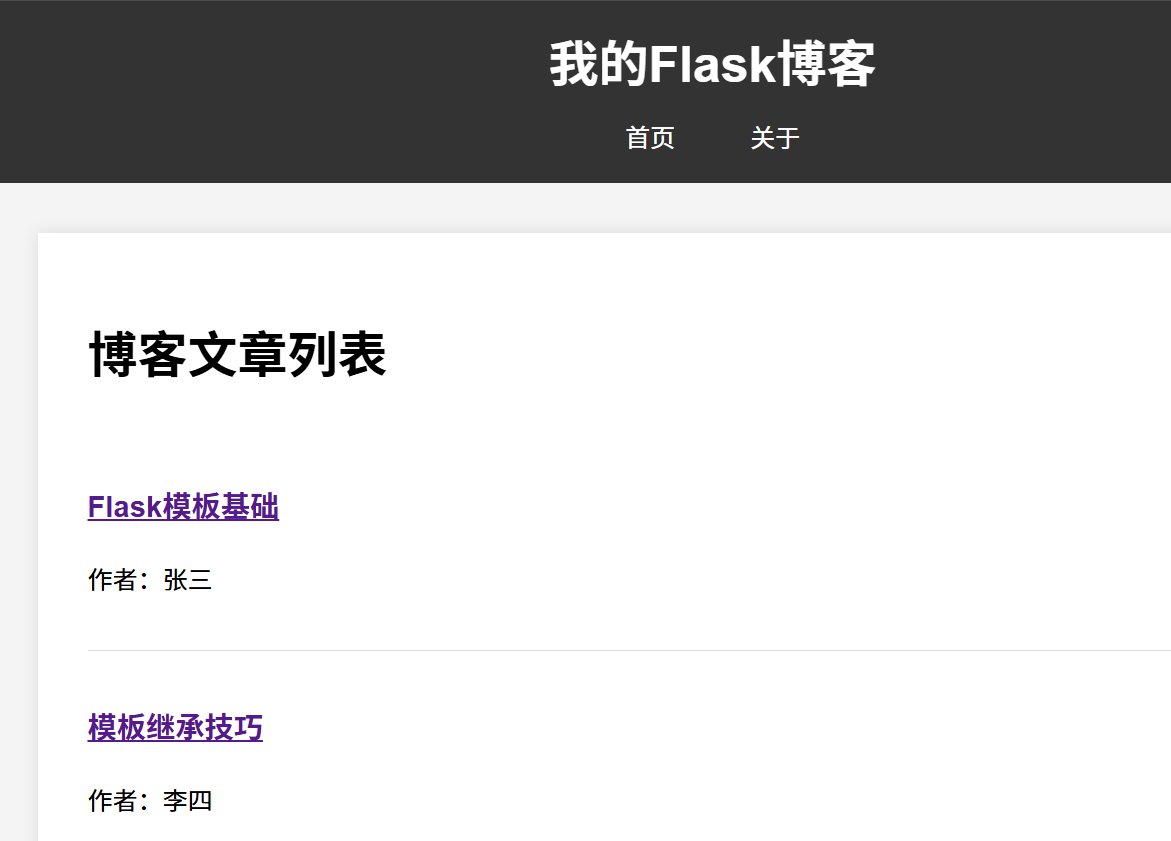Flask模板练习:
Flask模板练习
项目结构以及关系
Flask/
├── app.py
├── templates/
│ ├── base.html
│ ├── index.html
│ ├── post.html
│ ├── about.html
│ └── macros.html
└── static/
└── style.css
app.py
│
├── 定义路由和处理逻辑
├── 注册自定义过滤器
└── 提供数据给模板
│
└──▶ base.html (基础模板)
│
├── index.html (首页)
│ └── macros.html (使用 render_post_list 宏)
│
├── post.html (文章详情页)
│ └── macros.html (使用 render_post_content 宏)
│
└── about.html (关于页)
└── macros.html (使用 render_author_info 宏)

文件的功能
1. app.py - 应用主文件
功能:
创建 Flask 应用实例
定义自定义过滤器 reverse(字符串反转)和 colorize(生成随机颜色)
创建模拟的博客文章数据
定义路由处理函数
关键点:
使用 @app.route() 装饰器定义了三个路由:首页 /、文章页 /post/int:post_id 和关于页 /about
通过 render_template() 渲染模板并传递数据
自定义过滤器注册到 Jinja2 模板引擎:reverse_filter 和 random_color
from flask import Flask, render_template, url_for
import random
app = Flask(__name__)
# 自定义过滤器:将字符串反转
def reverse_filter(s):
return s[::-1]
# 自定义过滤器:生成随机颜色(现在接受一个参数,即使我们不使用它)
def random_color(s):
return "#{:06x}".format(random.randint(0, 0xFFFFFF))
# 注册自定义过滤器
app.jinja_env.filters['reverse'] = reverse_filter
app.jinja_env.filters['colorize'] = random_color
# 模拟博客文章数据
posts = [
{
'id': 1,
'title': 'Flask模板基础',
'content': '学习Flask模板的基础知识,包括变量、过滤器和控制结构的使用。',
'author': '张三'
},
{
'id': 2,
'title': '模板继承技巧',
'content': '深入理解Flask模板继承,掌握如何创建可复用的布局模板。',
'author': '李四'
},
{
'id': 3,
'title': '宏的高级用法',
'content': '探索Flask模板宏的高级特性和最佳实践。',
'author': '王五'
}
]
@app.route('/')
def index():
# 渲染首页模板,传递文章列表和页面标题
return render_template('index.html', posts=posts, title='博客首页')
@app.route('/post/<int:post_id>')
def show_post(post_id):
# 查找对应ID的文章
post = next((p for p in posts if p['id'] == post_id), None)
if post:
# 渲染文章页面模板,传递文章数据和标题
return render_template('post.html', post=post, title=post['title'])
return '文章未找到', 404
@app.route('/about')
def about():
# 渲染关于页面,传递标题和作者信息
return render_template('about.html', title='关于本站', author='赵六')
if __name__ == '__main__':
app.run(debug=True)
2. 模板文件(存放在 templates 目录)
a. base.html - 基础模板
功能:
提供网站的基本 HTML 结构
定义可被子模板继承的 block 区域
包含全局的页头、导航栏和页脚
关键点:
定义了 {% block title %} 和 {% block content %} 供子模板重写
使用 url_for(‘static’, filename=‘style.css’) 引入样式表
提供统一的导航栏,包含首页和关于页的链接
联系:
所有其他模板都通过 {% extends “base.html” %} 继承这个基础模板
<!DOCTYPE html>
<html lang="zh">
<head>
<meta charset="UTF-8">
<meta name="viewport" content="width=device-width, initial-scale=1.0">
<title>{% block title %}默认标题{% endblock %}</title>
<!-- 引入CSS样式 -->
<link rel="stylesheet" href="{{ url_for('static', filename='style.css') }}">
</head>
<body>
<!-- 页头部分 -->
<header class="blog-header">
<h1>我的Flask博客</h1>
<nav>
<ul>
<li><a href="{{ url_for('index') }}">首页</a></li>
<li><a href="{{ url_for('about') }}">关于</a></li>
</ul>
</nav>
</header>
<!-- 主要内容区域 -->
<main class="blog-content">
{% block content %}
<!-- 默认内容 -->
<p>欢迎访问我的博客!</p>
{% endblock %}
</main>
<!-- 页脚部分 -->
<footer class="blog-footer">
<p>© 2025 我的博客. 保留所有权利。</p>
</footer>
</body>
</html>
b. index.html - 首页模板
功能:
显示所有博客文章的列表
展示文章标题、作者和基本信息
关键点:
继承 base.html
使用宏 render_post_list 显示文章列表
显示文章数量和标题反转效果
通过 url_for(‘show_post’, post_id=post.id) 生成文章详情链接
联系:
通过 render_template(‘index.html’, posts=posts, title=‘博客首页’) 被 index() 路由使用
{% extends "base.html" %}
{% block title %}{{ title }}{% endblock %}
{% block content %}
<h1>博客文章列表</h1>
<!-- 使用宏来显示文章列表 -->
{% from "macros.html" import render_post_list %}
{{ render_post_list(posts) }}
<p>当前文章数量:{{ posts|length }}</p>
<!-- 使用自定义过滤器反转标题 -->
<p>反转标题示例:{{ title|reverse }}</p>
{% endblock %}
c. post.html - 文章详情模板
功能:
显示单篇博客文章的详细内容
展示文章标题、作者和正文
关键点:
继承 base.html
使用宏 render_post_content 显示文章内容
显示随机颜色背景的标签
提供返回文章列表的链接
联系:
通过 render_template(‘post.html’, post=post, title=post[‘title’]) 被 show_post 路由使用
{% extends "base.html" %}
{% block title %}{{ post.title }}{% endblock %}
{% block content %}
<article class="blog-post">
<h2>{{ post.title }}</h2>
<p>作者:{{ post.author }}</p>
<!-- 使用宏来显示文章内容 -->
{% from "macros.html" import render_post_content %}
{{ render_post_content(post.content) }}
<!-- 显示随机颜色背景的标签 -->
<div class="post-tag" style="background-color: {{ ''|colorize }}">
{{ post.title|lower }}
</div>
<a href="{{ url_for('index') }}">返回文章列表</a>
</article>
{% endblock %}
d. about.html - 关于页面模板
功能:
显示网站信息和作者信息
关键点:
继承 base.html
使用宏 render_author_info 显示作者信息
显示随机颜色背景的技术标签
联系:
通过 render_template(‘about.html’, title=‘关于本站’, author=‘赵六’) 被 about 路由使用
{% extends "base.html" %}
{% block title %}{{ title }}{% endblock %}
{% block content %}
<h1>关于本站</h1>
<!-- 使用宏来显示作者信息 -->
{% from "macros.html" import render_author_info %}
{{ render_author_info(author) }}
<p>本博客使用Flask框架构建,展示了模板继承、宏和自定义过滤器的用法。</p>
<!-- 显示随机颜色背景的技术标签 -->
<div class="tech-tag" style="background-color: {{ ''|colorize }}">
Flask模板技术
</div>
{% endblock %}
e. macros.html - 宏定义文件
功能:
定义可重用的宏,用于在多个模板中重复使用
关键点:
render_post_list(posts):渲染文章列表
render_post_content(content):渲染文章内容
render_author_info(author):渲染作者信息
联系:
这些宏在 index.html、post.html 和 about.html 中被导入和使用
{# 定义可重用的宏 #}
{# 渲染文章列表的宏 #}
{% macro render_post_list(posts) %}
<ul class="post-list">
{% for post in posts %}
<li class="post-item">
<h3>
<!-- 使用url_for生成文章链接 -->
<a href="{{ url_for('show_post', post_id=post.id) }}">
{{ post.title }}
</a>
</h3>
<p>作者:{{ post.author }}</p>
</li>
{% endfor %}
</ul>
{% endmacro %}
{# 渲染文章内容的宏 #}
{% macro render_post_content(content) %}
<div class="post-content">
<!-- 转义用户输入内容,防止XSS攻击 -->
{{ content|escape|replace('\n', '<br>') }}
</div>
{% endmacro %}
{# 渲染作者信息的宏 #}
{% macro render_author_info(author) %}
<div class="author-info">
<p>本站作者:{{ author }}</p>
<p>作者简介:这是一个Flask模板练习。</p>
</div>
{% endmacro %}
3. 静态文件(存放在 static 目录)
a. style.css - 样式表文件
功能:
提供整个网站的样式设计
美化页面元素
关键点:
定义了整体布局、字体、颜色等样式
为不同的 HTML 元素(如标题、导航栏、文章列表等)提供样式
使用 CSS Flexbox 实现响应式导航栏
联系:
通过 url_for(‘static’, filename=‘style.css’) 在 base.html 中被引用
/* 博客整体样式 */
body {
font-family: Arial, sans-serif;
line-height: 1.6;
margin: 0;
padding: 0;
background-color: #f4f4f4;
}
/* 页头样式 */
.blog-header {
background-color: #333;
color: white;
padding: 1em;
text-align: center;
}
.blog-header h1 {
margin: 0;
font-size: 2em;
}
/* 导航样式 */
.blog-header nav ul {
list-style: none;
padding: 0;
margin: 0;
display: flex;
justify-content: center;
gap: 1em;
margin-top: 0.5em;
}
.blog-header nav ul li a {
color: white;
text-decoration: none;
padding: 0.5em 1em;
border-radius: 5px;
transition: background-color 0.3s;
}
.blog-header nav ul li a:hover {
background-color: #555;
}
/* 主要内容区域 */
.blog-content {
max-width: 800px;
margin: 2em auto;
padding: 0 1em;
background-color: white;
box-shadow: 0 0 10px rgba(0,0,0,0.1);
padding: 2em;
}
/* 文章列表样式 */
.post-list {
list-style: none;
padding: 0;
}
.post-item {
border-bottom: 1px solid #ddd;
padding: 1em 0;
}
.post-item:last-child {
border-bottom: none;
}
/* 文章页面样式 */
.blog-post {
max-width: 700px;
margin: 0 auto;
}
.post-tag, .tech-tag {
padding: 0.5em 1em;
border-radius: 5px;
color: white;
display: inline-block;
margin-top: 1em;
}
/* 页脚样式 */
.blog-footer {
background-color: #333;
color: white;
text-align: center;
padding: 1em;
margin-top: 2em;
}























 913
913

 被折叠的 条评论
为什么被折叠?
被折叠的 条评论
为什么被折叠?








